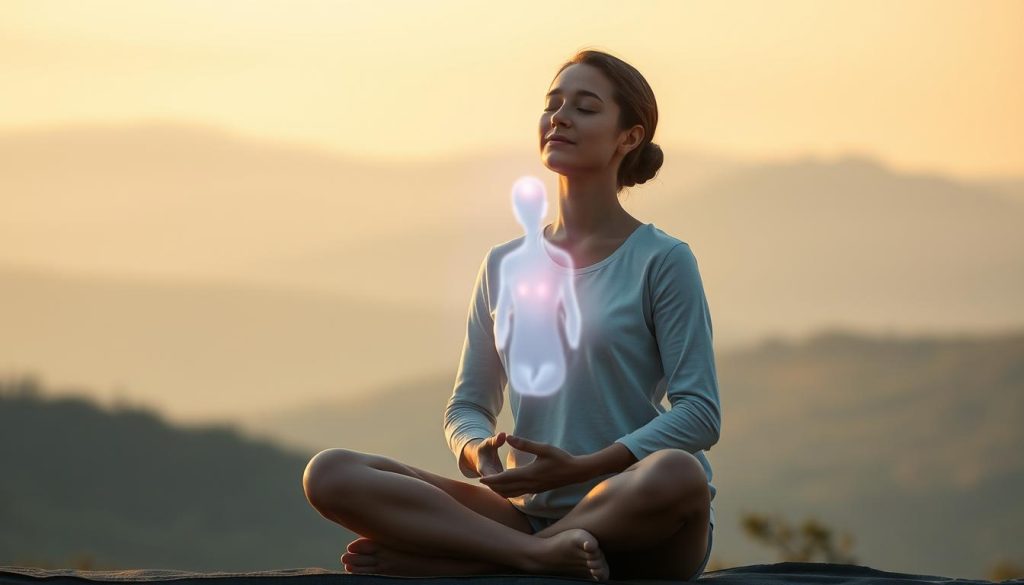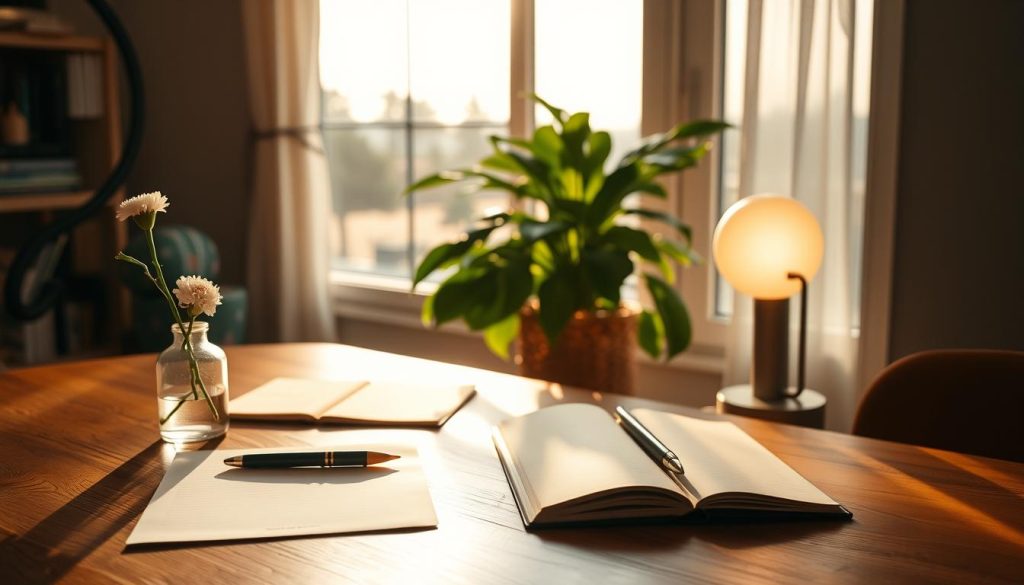We once met a consultant in Paris who stopped three times a day to breathe for a minute. She kept a notebook of choices made after each pause. Over months, her emails were clearer and her mornings less frantic.
That simple habit shows the core idea: engaged presence helps you protect energy and sharpen focus in a fast world. Haley Parker, DAcCHM, defines mindfulness as being fully present with body, breath, emotions, and environment in a nonjudgmental way.
Anita Yokota adds that it activates the prefrontal cortex and quiets the amygdala, so decision-making and emotional control improve under pressure.
This section explains a practical way to start. Small, consistent steps—like a one-minute, 5-second inhale/5-second exhale reset recommended by Cleveland Clinic—stack into real benefits for work and life.
We promise no need for long sessions or special gear. You will learn short meditations, movement options, and when music or a quick pause can steady your day.
Table of Contents
Key Takeaways
- Short, regular moments of presence improve focus and reduce stress.
- Experts show brain changes happen with consistency, not perfection.
- A one-minute breathing reset is a practical entry point.
- Small routines compound into durable benefits for independent professionals.
- You can use movement or music to reset attention during the day.
What Mindfulness Means at Work Today
Work demands often drown out clear attention; reclaiming a small space to notice makes a big difference.
We define mindfulness at work as paying attention, on purpose, to the present moment—bringing awareness to your mind, body, and environment so you can respond rather than react.
In practice, you create a short pause between stimulus and response. That pause is where clarity happens. It reduces racing thoughts and the « always on » fatigue many professionals report.
Physical signs—jaw clenching, irritability, or feeling drained at day’s end—serve as cues to reset. Simple steps help: guided meditation, trying different times of day, or habit stacking (one mindful breath after brushing teeth).
- Start small: one breath or one step anchors attention to the present moment.
- Make it routine: tie short bursts of awareness to daily anchors like coffee or login.
- Experiment: indoor vs. outdoor, eyes open vs. closed to find what fits your environment and life.
See our practical guide for building resilience and reducing stress in a freelance career: resilience and stress management.
Why Mindfulness Builds Career Resilience
Neuroscience shows how short, steady pauses reshape your capacity to respond under pressure.
From prefrontal focus to a calmer amygdala: the neuroscience
Mindfulness engages the prefrontal cortex—your executive center—while quieting the amygdala, the brain’s alarm. This creates a clearer lane for judgment when stakes are high.
- Improved focus: the prefrontal boost supports sustained attention during complex tasks.
- Lower reactivity: a calmer amygdala reduces immediate fight-or-flight responses that drive anxiety.
Attention, problem-solving, and performance under pressure
When attention is trained, problem-solving improves. Brief mindfulness meditation and short meditations of one minute sharpen working memory and decision speed.
Leaders report a growing gap between trigger and response. That gap lets you choose strategy over impulse in client negotiations or crisis moments.
Nervous system balance, sleep quality, and reduced reactivity
Regulating the nervous system via paced breathing lowers physiological arousal. The Cleveland Clinic-style 5s inhale / 5s exhale sequence increases oxygenation and cognitive flexibility.
Consistent, short sessions help the body return to baseline faster, improving sleep continuity and steady performance across times and days.
Quick Ways to Practice Mindfulness in a Busy Day
Tiny pauses, used reliably, give you back focus on the busiest days. Below are short, actionable steps you can use between meetings or while you wait for a call.
One-minute meditation you can do in your car or at your desk
Use a discreet one-minute meditation: inhale five seconds, exhale five seconds, and repeat five times. This protocol fits into tight schedules and resets attention fast.
Box breathing to steady your breath and mind
Try box breathing when you’re overwhelmed: inhale, hold, exhale, hold—each for equal counts. It reduces stress and brings quick nervous-system balance.
Habit stacking: tie mindful moments to routines
Attach micro-exercises to daily anchors—after coffee, before you open a laptop, or when you log in. These steps make it easy to practice mindfulness several times without adding extra time.
“Return to the breath” when anxiety spikes
When you’re feeling anxious, pause for one calm cycle of breath. Name the trigger aloud if you can, then proceed. Small returns to the breath help stop reactive patterns and improve decision-making.
For a broader approach to mental health and resilience, see your guide to mental health and.
mindfulness practices You Can Start Now: Breath, Body, and Awareness

Three brief methods—scan, breath, and label—are enough to interrupt stress and reset attention. These tools fit a busy schedule and help you downshift without adding time to your day.
Body scan to release tension and improve awareness
Run a short body scan for 3–5 minutes. Move attention from crown to toes, notice sensations, and release micro-tension. This exercise builds interoceptive awareness and improves self-regulation.
Mindful breathing to anchor attention to the present moment
Follow the natural breath; do not force it. Let the breath be your metronome to stabilize attention. Exhale slightly longer than the inhale to signal calm to the nervous system.
Mental labeling to interrupt rumination and worry
When worry or anxiety appears, quietly name it: “thinking,” “planning,” or “tightness.” Labeling creates distance and stops spirals quickly.
- Mix tools: one minute of breathing, one minute of scan, one minute of labels.
- Use a daily anchor at start or shutdown to make the practice sustainable.
- Before client calls, take one conscious breath to improve clarity.
For further reading on stress reduction and recovery, see our stress and relaxation guide.
Mindful Movement: Walking, Yoga, and Tai Chi for Everyday Balance
Syncing steps to breath turns a simple walk into a compact reset for energy and focus. Use this method between meetings to clear the head and steady attention.
Walking meditation can be done on the way to work, around the block, or in a nearby park. Pace slowly and notice footfalls, air on your skin, and environmental sounds. A gentle rhythm—four steps inhale, four steps exhale—helps steady the mind while you move.
If sitting still is hard, choose intentional movement like yoga or tai chi. These exercises reconnect the body and reduce muscle tension. They also improve balance and mobility while anchoring you to the present through sensory cues.
Keep it practical: 5–10 minutes before deep work or a client call recharges focus. Scan posture, relax shoulders, and align the spine as you walk. Small micro-adjustments boost energy and lower physical strain that drains decision-making.
- Use slow walking between tasks to sync breath and pace.
- Let light, color, and sounds in the environment become anchors.
- Add low-volume instrumental music if it helps maintain cadence without distracting.
- Do two short movement breaks daily and note post-walk changes in energy or clarity.
For guidance on sustaining small daily changes that support career stability, see our resource on personal growth and balance.
Everyday Sensory Practices to Cut Stress and Boost Focus

Small sensory shifts through the day can quickly lower stress and sharpen focus.
Mindful eating: chew slowly for each bite, savor textures and flavors, and take the first minutes of a meal in silence. Try using your non-dominant hand and avoid screens to give your pace a reset.
Deep seeing: pick an object and study its color, edges, and light for three to five minutes. Let your eyes rest on one thing; this trains sustained attention and reduces visual fatigue.
Deep listening: begin with your breath, then widen to room sounds and the world beyond. Notice close and far sounds in layers to calm the nervous system and expand awareness.
Single-tasking: choose one priority for your next work block. Close extra tabs, align posture, and track one steady breath to maintain focus and reduce cognitive drag.
Transition pauses: pause at thresholds — before calls, meetings, or entering a room — to create a brief space to choose tone and outcome. When you’re feeling scattered, grab a sensory anchor (the warmth of a mug or texture of a pen) for 30 seconds.
| Everyday Habit | How to Do It | Time | Benefit |
|---|---|---|---|
| Mindful eating | Chew slowly, no screens, savor taste | 5–15 min | Slows pace, reduces stress |
| Deep seeing | Study an object for 3–5 min | 3–5 min | Improves sustained attention |
| Deep listening | Layer breath, room, outside sounds | 1–3 min | Calms nervous system |
| Single-tasking & pauses | Close tabs, align breath, pause at doorways | 30 sec–10 min | Sharper focus and deliberate responses |
Tools and Community to Sustain Your Practice
A reliable system combines simple tech and social routines to keep short sessions alive.
Use minutes, not hours: apps like Aura send 3‑minute reminders and offer a gratitude journal. Stop, Breathe & Think gives fast check-ins that match suggested meditations to your state. Simple Habit maps 5‑minute tracks to real work times (commute, pre-meeting). BetterSleep mixes sounds and short sleep meditations to improve recovery.
Group formats deepen commitment. Try eye gazing to build presence, partner breathing to sync regulation, or laughter yoga to release tension. These options make the work visible and social.
Creative outlets support regulation too. Coloring, Zentangle, crafting, music, and mindful gardening engage hands and body. Keep a small book or printable mandala nearby for quick visual resets.
- Automate minutes-a-day with Aura and Simple Habit for consistency.
- Use BetterSleep to harmonize breath and rhythm at night.
- Schedule group sessions to create space and accountability.
- Track benefits in focus duration and recovery time to justify ongoing use.
| Resource | Use | Minutes | Primary benefit |
|---|---|---|---|
| Aura | Reminders, gratitude journal | 3–5 | Consistency and reflection |
| Simple Habit | Situation-based sessions | 5 | Practical fit for work |
| BetterSleep | Sounds + short meditations | 10–20 | Sleep quality and recovery |
| Stop, Breathe & Think | State check-ins with meditations | 2–5 | Tailored short relief |
Make times and spaces explicit. Join a group or book a recurring slot, and measure benefits against work metrics. For tips on balancing these routines with client work, see our guide to balancing work and life.
Conclusion
Short resets build a durable buffer between trigger and response in daily work.
Begin with one clear step: one mindful breath, one minute, one choice. These tiny actions compound into hours of calm over a year.
Practical tip: make a simple meditation practice—two or three short minutes tied to a daily anchor. Log outcomes in a small book to track gains in focus and decision quality.
When stress rises, shorten the loop: one breath, name the feeling, relax the body, proceed. Use light music or silence based on the task.
We invite you to start where you are, repeat what works, and keep the approach kind. Practicing mindfulness is not perfection; it is steady care for your mind and life.
FAQ
What does mindfulness mean in a professional context?
In a work setting, it means paying steady attention to present-moment experience — breath, body sensations, thoughts, and surroundings — so you respond with clarity rather than react from habit. This improves decision-making, communication, and resilience under pressure.
How does a short daily practice support career resilience?
Even minutes of focused breathing or a brief body awareness exercise strengthen attention networks and reduce stress reactivity. Over weeks this leads to better focus, calmer problem-solving, and more consistent performance during demanding periods.
Can neuroscience explain the benefits for leaders and freelancers?
Yes. Regular attention training enhances prefrontal control and soothes the amygdala, which lowers impulsive responses. That neural balance supports planning, emotional regulation, and steadier judgment in high-stakes situations.
What is a one-minute technique I can use between meetings?
Try a focused breathing reset: close your eyes if possible, inhale for four counts, hold two, exhale for six. Repeat three cycles while noticing bodily sensations. It grounds attention and reduces immediate anxiety.
How does box breathing help during stressful calls?
Box breathing (equal counts for inhale, hold, exhale, hold) slows respiration and activates the parasympathetic system. This reduces heart rate and clears the mind, enabling more composed responses in tense conversations.
What is habit stacking and how do I apply it at work?
Habit stacking links a short awareness moment to an existing routine — for example, one minute of mindful breath after you pour coffee or before opening email. It makes practice automatic without extra scheduling.
How can I use the body scan when I feel tense at my desk?
Do a brief top-to-toe scan: notice the forehead, jaw, shoulders, chest, abdomen, legs. Breathe into areas of tension and consciously release. This reduces muscular stress and brings attention back to the present.
What is “return to the breath” and when should I use it?
It’s a simple anchor: when worry or racing thoughts appear, gently shift attention to the sensations of breathing. Use it whenever anxiety spikes, before a meeting, or during difficult feedback to regain composure.
How does mindful movement like walking or yoga fit into a busy schedule?
Short, intentional movement sessions — a five-minute walking meditation between tasks or a ten-minute stretching routine — sync breath and rhythm, reset posture, and improve circulation, making them practical micro-breaks for sustained focus.
What sensory practices help reduce stress quickly?
Engage senses deliberately: slow your chewing at lunch, practice deep seeing by observing colors and shapes for 60 seconds, or listen attentively to a piece of music. These exercises interrupt autopilot and restore attention.
How does single-tasking improve productivity?
Focusing on one task at a time reduces cognitive switching costs. By allocating uninterrupted blocks for priority work and using brief transitions to reset, you deliver higher-quality output with less fatigue.
Which apps and tools are helpful for short daily sessions?
Choose reputable apps that offer guided minute-based sessions and sleep tools, such as Headspace, Calm, or Insight Timer. Use timers, wearable reminders, or calendar micro-blocks to maintain consistency.
Can group practices enhance individual routine and well‑being?
Yes. Team breathing exercises, partner rhythm work, or guided group meditations build social support, increase accountability, and create a shared culture of calm that sustains personal habits.
Are creative activities like music or gardening considered valid ways to practice awareness?
Absolutely. Engaging in art, crafting, music, or gardening with full attention trains concentration, lowers stress, and offers restorative breaks that complement formal sitting or breath-focused exercises.
How quickly will I notice benefits and how often should I practice?
Many professionals report immediate calming effects after a single short session. For lasting change, aim for brief daily routines — even five to ten minutes — combined with situational anchors throughout the day to reinforce skill.





